
Reimagining the future: The Winnebago Horizon
The Messe complex is about a 15-minute train ride from downtown Dusseldorf, Germany. At the end of summer, sprawled across nineteen exhibit halls is the Caravan Salon, the world's largest RV show attracting over 200,000 visitors with 500 vendors and 2,000 towables and motorhomes on display. The investment in the displays is significantly greater than what American RV buyers see compared to the parking-lot style of indoor and outdoor shows held across the country. It reflects the premium the European market places on design, from the way product is presented, to the product itself.
The Catalyst to Change
Descending an escalator between halls seven and nine, down to the train platform, Ryan Roske was feeling the out-of-sync end of day letdown from jet lag. As Winnebago's product manager for the company's line of diesel pusher motorhomes, he had just completed his first day's mission of rambling through the many halls taking notes and dozens of pictures.
Growing up in Winnebago's hometown of Forest City, Iowa, Roske had risen through the sales path to become a product manager. And now his trip to the Caravan Salon was adding another link in the chain of the company's commitment to discover, source, and embed world-class components into its motorized products.
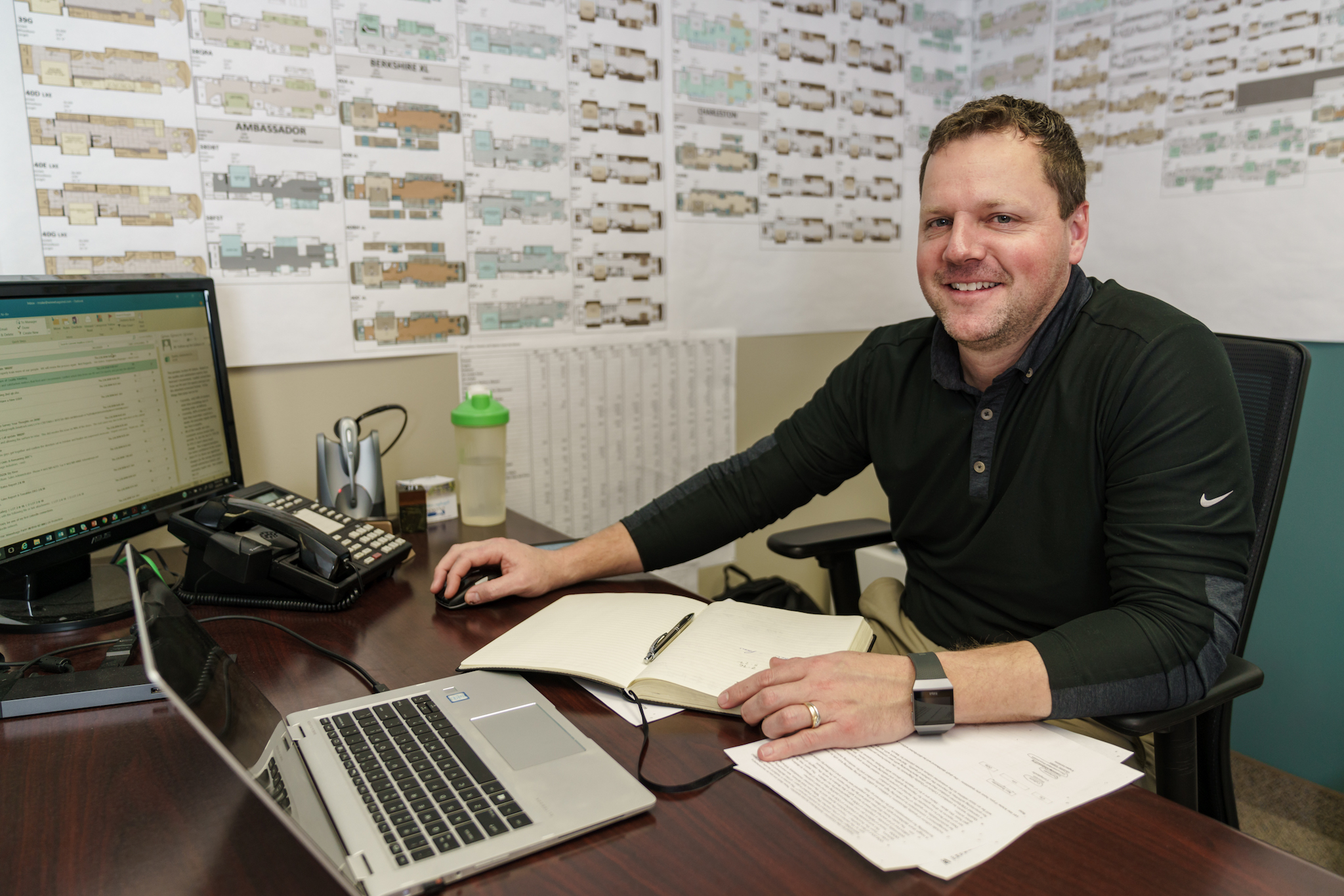 Keeping a watchful eye on the competition, Winnebago product manager Ryan Roske's office is mapped with the competitor's floor plans.
Keeping a watchful eye on the competition, Winnebago product manager Ryan Roske's office is mapped with the competitor's floor plans.
More than any other American motorhome manufacturer, Winnebago has paid very close attention to the European market for nearly three decades. With gas shortages in the mid-1970s, the company turned to fuel-efficient German and French chassis to build higher mileage products. In 2006 it was the first U.S. company to construct a motorhome on the Mercedes Sprinter light delivery van chassis. But beyond chassis mechanics, Winnebago also paid very close attention to the sleek, super-efficient interior designs inside all the small Euro motorhomes. And, a few years after the launch of the company's best-selling View/Navion Sprinter motorhomes, they switched to an Italian company to specially manufacture the interior cabinetry.
The gentle rocking of the train to Roske's downtown hotel added weight to eyelids that were still set for a time zone seven hours behind. With his backpack between his legs, he closed his eyes for a moment to begin sorting out the day's visual stream of rounded corners, glass-polished cabinet surfaces, and envelopes of edge-glow lighting. He had come to Dusseldorf fairly confident that the company should risk going against what would come to be called "the sea of sameness" of RV interior design, but now he was sure, absolutely sure, that it was time to set in motion events that might very well bring the biggest change to American motorhomes in decades.
Historically, interior RV design had mirrored the deep roots of midwestern cabinet makers with traditional hardwoods with the sculpted trim being the invariable standard for every manufacturer and every product line. The View/Navion products were different. While the Mercedes star brought intrigued first-time buyers into RV dealers, Winnebago's more sculpted and contemporary interiors sealed the deal offering buyers a distinctly more contemporary and stylish mobile living environment.
Designed for Luxury and Class
Four thousand, three hundred, fifty-nine miles away in Forest City, Bob Ritter was leafing through clippings and images of yachting magazines. Also, an Iowan native, Ritter could easily fit the role of the gruff, but always fair high school football coach. For fourteen years, Ritter had steered a team that always had to balance a complicated list of variables. Surfaces, colors, tactile effect, durability, temperature resistance, livability, and functional efficiency were all pushed hard against the constraints of manufacturing processes and final price tag. And the photos he was looking at all were from products whose single cost would be greater than the combined value of four full blocks of well-tended homes up the hill from Winnebago's main plant.
 Bob Ritter led an in-house team that boldly broke out of traditional design with a complete rethink of a modern interior.
Bob Ritter led an in-house team that boldly broke out of traditional design with a complete rethink of a modern interior.
In the rarefied air of ultra-luxe motorhomes of over one million dollars, when you walk into brands like Newell, Foretravel, and Marathon, you're looking at design elements that brook no compromise and are priced accordingly. Yet in a quirk of American consumerism, many of these ultra-luxe coaches often have little design coherence. Their designs are often driven by the owner's whims and just like their lower-priced RV cousins, they can still feel like they were assembled out of the same parts bin, albeit with filigreed wood, ornate trim, and cut-glass cabinet insets. In envisioning a truly contemporary designed motorhome, both Roske and Ritter were looking at a different inspirational model -- luxury yachts. Of the top ten yacht builders in the world, nine are from Europe and only one is from America. At prices ten to twenty times greater than their luxury RV land counterparts, these toys for the super-rich more often than not reflect the minimalist elegance of high Italian style with rare hardwoods and formed and lacquered composites.
For the View/Navion series, Winnebago had found a family-owned cabinet manufacturer, Technoform, in Bologna, Italy. They had many European clients including high-end yacht companies, so it was a pretty big accomplishment for Technoform to land an American brand. Technoform had the ability to shape and mold cabinets with precise, graceful curves both concave and convex. They did it with a process and special machinery that would form laminate materials into doors and front pieces. This process also allowed the rich design of wood-like surfaces or deep chromatic laminate colors. The surfaces themselves could be finished with mirror-like reflectivity or subtly textured matte qualities. For motorhome use, the cabinetry components were dimensionally stable which made them immune to size changes due to humidity and temperature variations. And finally, for as strong and durable as the cabinets were, they were remarkably lightweight, which was a critical requirement for the smaller Sprinter-based motorhomes.
Paving a New Path
Early on, there had been some discussion about simply taking an existing coach line like the company's entry-level Forza models and simply re-skinning the interior with more contemporary cabinetry. Winnebago even mocked up a sample galley with other Technoform components used in the company's Era Sprinter van. It was placed alongside other potential cabinet fronts which were put on display at a dealer meeting in Las Vegas in 2014. But dealers were skeptical. They knew that, by and large, most of their buyer's homes were more traditionally furnished and felt that many wouldn't embrace an aggressively modern interior. Doubts and opinions were strong and both Roske and Ritter worried that pushing the taste envelope could be the kind of bet that limits careers and leaves competitors snickering.
Roske returned from Europe fully resolved that the creation of a completely modern mid-luxury diesel pusher motorhome would find market acceptance. While there were timidity and skepticism in the dealer network, Roske had heard plenty of first-hand comments from motorhome owners that they loved what the company was doing in its smaller Euro-based motorhomes and vans.
There's an adage in the RV industry that says, "Floorplans sell motorhomes." And to some extent that's true. For those who've shopped for RVs at shows and on dealer lots, floor plans and finishes all become a blur after the first hour's survey. To break through the product monotony, manufacturers will often create design features that look indispensable at the show, but end up being ignored in real use. More than most, Winnebago's floorplans are constantly being adjusted based on owner feedback.
The First 'Buck'
Aligning the engineering, product planning, and interior design teams started a process where collectively they would consider length and floor plan style. For this new product, it was decided there would be two plans. The shorter one would have a single bath and the longer one a bath and a half. The planners selected two very successful core designs that had found great favor in other Winnebago coaches. But for the shorter model, they made a very interesting tweak to the single bath with a pass-thru entry from the main hall and from the master bedroom.
In a large warehouse in the factory complex, they began to assemble the framework of a new motorhome. It sat simply on wood risers, not an actual chassis. Just like building a home, the full-scale model took shape with framing, exterior walls, and a roof. The prototype is called a "buck," a name given to the process so long ago that no one can recall how the term came to be. Special factory craftsmen hand built all the structural components of the buck based on all the computer-aided design drawings of the approved floor plan. Concurrently, Winnebago sent the dimensions and surface finishes to Technoform to tool up and build components for a single coach.
It's a time consuming, complicated and expensive process working across languages and time zones, creating something from scratch where there are no road maps. And over the months, dozens of people worked on various aspects of the mockup. While Technoform was to supply the cabinets, the furniture such as the driver and passenger captain chairs, couches, and side chairs would all be manufactured domestically to Winnebago's specs.
Ritter and his team had long trusted the UltraFabrics company who's Ultraleather fabrics are used extensively in Winnebago products. Ultraleather is a premium synthetic leather fabric that is manufactured by patented technology from a Japanese mill. While its "hand" and texture can be completely indistinguishable from real leather, its durability, stain resistance, ability to withstand the heat and cold of off-season coach storage, and remain colorfast are superior to leather. And underneath the Ultraleather upholstery are fillers, padding, and suspensions that are built to high-use commercial grade quality. Once the cabinet components were installed in the buck, then the furniture was placed.
The interior design team knew that just bolting new cabinets to the walls and placing some modern looking furniture nearby wasn't going to make the big leap from nice to remarkable. They spent a great deal of time evaluating different wall and surface textures. A variety of treatments were experimented with before settling on several never-seen-before laminate textured surfaces Technoform had developed.
As fashion forward as the cabinet surfaces were, hardware was selected that was equally as modern. One of the most evident applications would be the brushed steel barn door suspension hardware on the bath -- a space saving technique used in modern urban lofts and boutique hotels.
They gave a great deal of thought to a ceiling treatment that would hide and diffuse the rooftop air conditioners, but also provide a soft envelope of coach lighting. While a viewer's eye would be drawn to fabrics and curving surfaces, perhaps the greatest perceptual impression would be the least paid attention to -- a ceiling with a disciplined simplicity.
The creation of the buck served two important purposes, the first as a fully immersive proof-of-concept for the radical new deep Euro look. The second was a working laboratory where manufacturing issues on wiring, line assembly, and components could be fine-tuned. Now complete, the future would be quietly displayed to a handful of dealers who, after walking down a long corridor, through a nondescript white door, into a dimly lit warehouse, would step up on a plywood box and walk onto the porcelain tiled floor of the future.
The Birth of the Horizon
The reactions were pretty uniform in their surprise and excitement. "Do you really think you can build a production unit that looks like this?" one admiring skeptic asked. "Sure we can," Roske replied, but in the back of his mind, he was thinking of component logistics and spreadsheets of cost analysis knowing that there were a lot of details to be worked out. Standing in the buck, Roske knew that this yet-to-be-named motorhome would also rewrite Winnebago history to be the first all-new model not to be made in the company's Forest City plant.
The Great Recession treated the RV industry with extra viciousness. Almost overnight it snuffed out a large swath of manufacturers with well-known names. Monaco, Holiday Rambler, and Country Coach were just a few. Winnebago's workforce shrunk by half from four to two thousand and, perhaps the most extraordinary number of all was seeing business plummet from nearly one-billion dollars a year to two-hundred and fifty-million -- a seventy-five percent drop.
There were two things that kept Winnebago from joining other storied brands as little white crosses next to the RV highway. The first was no debt and sufficient operating capital. That admired Midwest Iowan business conservatism had served the company well. The second thing is that they were still selling some products. Specifically, the Euro-inspired View/Navion models which were surprisingly still in demand. Painfully, order by order, quarter by quarter, the company and the RV industry began to walk out of the smoke of the wreckage.
Market demand and momentum started to build. Good, but undercapitalized, manufacturers were acquired. Among those was the Middlebury, Indiana trailer company, Sunnybrook, that Winnebago bought. Then, in 2015 the company's senior vice-president stood in front of a small podium surrounded by dozens of dealers and Winnebago employees at the industry's annual show in Louisville, Kentucky and announced the company's acquisition of Country Coach in Junction City, Oregon, just north of Eugene.
Country Coach had built a passionate following of luxury diesel coach owners. It was known for its well-built chassis and high-quality interior assembly. Winnebago viewed the acquisition as a positive for two reasons. First, it would provide a west coast presence for direct factory service. And second, there was a skilled motorhome manufacturing workforce in the area. By 2014 it was evident that, across the industry, there was a strong resurgence of buyers. Workers were added back to the assembly lines in Forest City as the company geared up for new orders.
In motorhome manufacturing, there are two common approaches. The most common one is bay assembly. For Winnebago, with larger volumes, a three-path assembly line was developed over the decades for high volume. But, the company and its dealers had learned, after the recession, that the consequences of having too many unsold rigs at a dealership weren't a good thing. The term they used for it was "lot rot." So, instead of making a big guess and building twenty of a particular model at one time, Winnebago had to adeptly adjust by creating a logistical symphony of parts and technicians that would work on lines where a Class A diesel might be followed by a Class C Sprinter, and then a Class A Ford gas chassis.
With a west coast facility that was purpose-built for diesel pusher manufacturing, Winnebago began a two-year project to transition the big rig manufacturing to Junction City. It would free up capacity for Winnebago's other product lines, but it also represented a significant change in supply chain, support services (like exterior painting), and manufacturing processes. Unlike Forest City, the Oregon plant used a bay assembly process which, for large-scale coaches with big slide rooms, was actually more efficient. And it was here that Roske's new model, now badged with a past nameplate of the Horizon, would be built.
While the true innovation story of the Horizon rested with its advanced coach design, it would sit atop Winnebago's exclusive chassis of choice manufactured by the Daimler-owned Freightliner Custom Chassis in Gaffney, South Carolina. Depending on model, the chassis would come with a high horsepower Cummins diesel engine. Winnebago had perfected an important change to the basic Freightliner design with their Maxum branded chassis that lowered the motorhome's center of gravity and provided capacious underneath storage. The skeletal frames of newly delivered chassis were neatly parked next to the plant to be driven into the assembly bays where the Horizon would take shape.
Risky First Impressions
The term "line pilot" is given to the first units assembled. These are the ones that are the next step beyond the full prototype. It's here that final engineering and assembly steps are adjusted for efficiency and quality. As the line pilots were set to go under construction, a small group of Winnebago dealers was meeting in Phoenix as part of a periodic advisory process. Roske couldn't attend in person but sat in as a voice on the speakerphone in the middle of the room. When the conversation turned to the Horizon, the tone was optimistic, but after a while doubt started creeping into the conversation. Was this too big a risk? Would buyers smile, but turn their back on such a sleek approach. The negativity started building until one long-time dealer defended the project and made the case that with great risk, comes great reward. Things would continue to move forward, but in the back of Roske's mind the list of logistics from supply chain to marketing seemed to grow even longer.
If the move to an aggressively clean European design seemed like a risk, the debate around what the exterior should look like was even more fraught with anxiety. After all, one's first impression of a motorhome is when it's being looked at from the outside. This was the problem staring at Matt Clements.
Clements is the head of exterior design. Like almost all the departments on the Forest City campus, Clements and his team work out of a windowless area tucked away in the back of the main administration building. On entering, one is struck by the bright lighting and, in the middle of the main design area, hanging on big frames, are full-sized clay models of both fronts and backs of whatever future coach is being contemplated. Designers check sketches and CAD drawings to physically sculpt the front and back caps with modeling clay. Ultimately these models will be scanned and that data will be used to create the forms from which the caps will be molded.
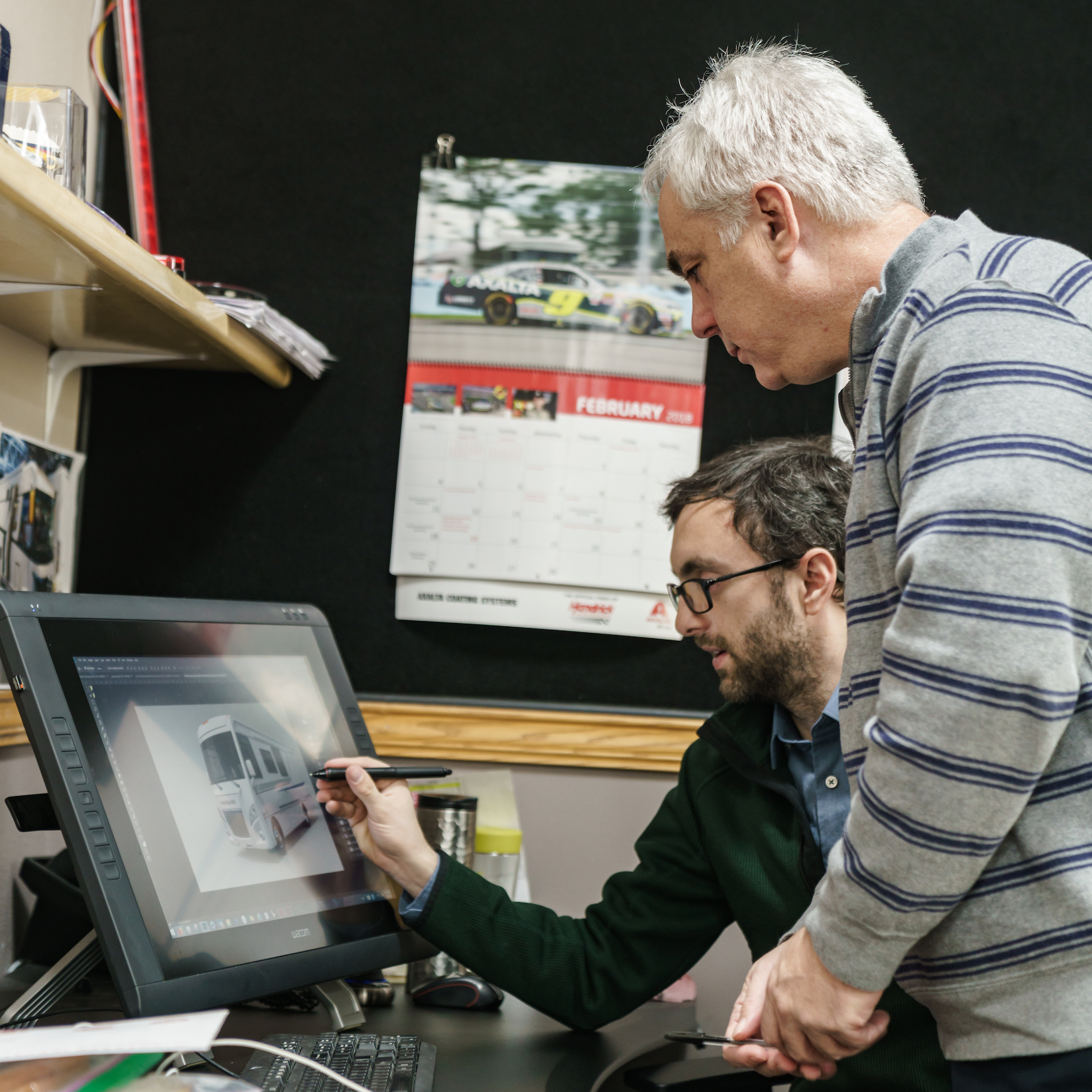 Matt Clements (R) reviews the design of the new Winnebago Intent which, like the Horizon, is a big departure from traditional external graphic treatments.
Matt Clements (R) reviews the design of the new Winnebago Intent which, like the Horizon, is a big departure from traditional external graphic treatments.
While sculpted by hand, the precision of inset lines, headlight locations, and front cowling curve are astonishingly precise as they are painstakingly shaped with the same tools a fine artist would use. And, not surprisingly, many of the members of Clements' team pursue artistic hobbies off work.
At sixty-five miles an hour, all motorhomes essentially look like shoeboxes on wheels as they rush by. But at a campsite, a driveway, or RV resort it's a different story. Not only did the designers want to create a pleasing and inviting look -- something that said, "Come drive me," but also a consistent visual theme that ran across the model line. Like the difference in faces, the front ends take on personification of eyes, cheekbones, and smiles. In describing the Horizon, Clements uses terms like "confident," "purposefulness," and "positive tension" as he talks about the impression good design should leave. He explains that "Our real challenge is to work within many constraints to come up with something that beckons, but still stays within the existing geometry -- and finally is recognizable as a Winnebago."
Ditching the Swirls
Beyond the physical dimensions of exterior RV design, the elephant in the room is. . .how to paint the elephant. When once asked of the long-term editor and publisher of Motorhome Magazine, "Where did the swirls come from?" He paused, thought about it for a moment, and tentatively said, "It's been so long, I can't remember." One long-term industry insider claims that swirls appeared first on the 1993 Beaver Patriot. What's clear is that for over two decades the American RV industry has been tightly wrapped up with swirls, swooshes, and flairs.
In one of the rooms where Winnebago exterior designers work, the walls are covered with laser prints of thumbnail models of RV sidewalls in various colors for various models. Altogether creating a sense of a palette display in a paint store. On closer inspection, the patterns change in intricacy, but then there's one group that clearly stands out based on its simplicity. What's noticeably absent is what Clements calls "graphic drama." These designs show a visual simplicity that hews to the visual concept of negative space, where the eye finds a balance in the total view.
From the front of the coach Clements' team begins with a dark accent paint that sweeps up and rises to exit to the rear of the coach. Below is a monochromatic base that is separated by textured paint that the designers call a fade. And finally, below are thin horizontal stripes that bisect the lower expanse as if an artist dragged a paintbrush along the side as if to finish the canvas. The effect, to RV aficionados, is at once both heretical and innately pleasing.
Introducing the Finished Product
It was now a month before the Horizon's official launch at an industry event called the Open House in Elkhart, Indiana. Elkhart has the largest concentration of RV manufacturers in North America. A few years ago, some of the biggest companies headquartered there decided to throw their doors open to dealers. Unlike trade shows, which are concentrated in one place, the Open House takes place throughout the greater Elkhart area in fields, parking lots, and plant facilities. The two-line pilot Horizons would ultimately have to make their way from Oregon to Indiana. But first, a stop off in Denver was planned to use this modern city as a backdrop for photography and video.
On the day of the total eclipse, the two Horizons were parked at the base of a three-story open stairway in downtown connecting Denver's toniest and newest urban neighborhood. The surroundings matched the Horizon's aggressively modern design and, as the drivers moved them into position, passerby's slowed in curiosity to watch two big rigs maneuvered to the base of the stairway, jacks set down, and slides pushed out.
Roske and the company's marketing team stepped in and out of the coaches for final preparation while a photographer launched a small drone to capture a top-to-bottom video arc, with the Horizons beneath the 12-story suspension mast of the pedestrian bridge.
For an intimate private showing, a small invited group had gathered outside of Denver's historic Union Station and alongside Winnebago's CEO, Mike Happe, and the motorized division's vice-president, Brian Hazelton, walked two blocks to the West to the base of the Millennium Bridge, crossing the freight line tracks. From the top of the bridge they could see a large park with the South Platte River and the front range of the Rocky Mountains in the distance. It was here, less than 1,000 feet away, where Denver would germinate about a hundred years after the rendezvous of French fur trappers and plains Indians.
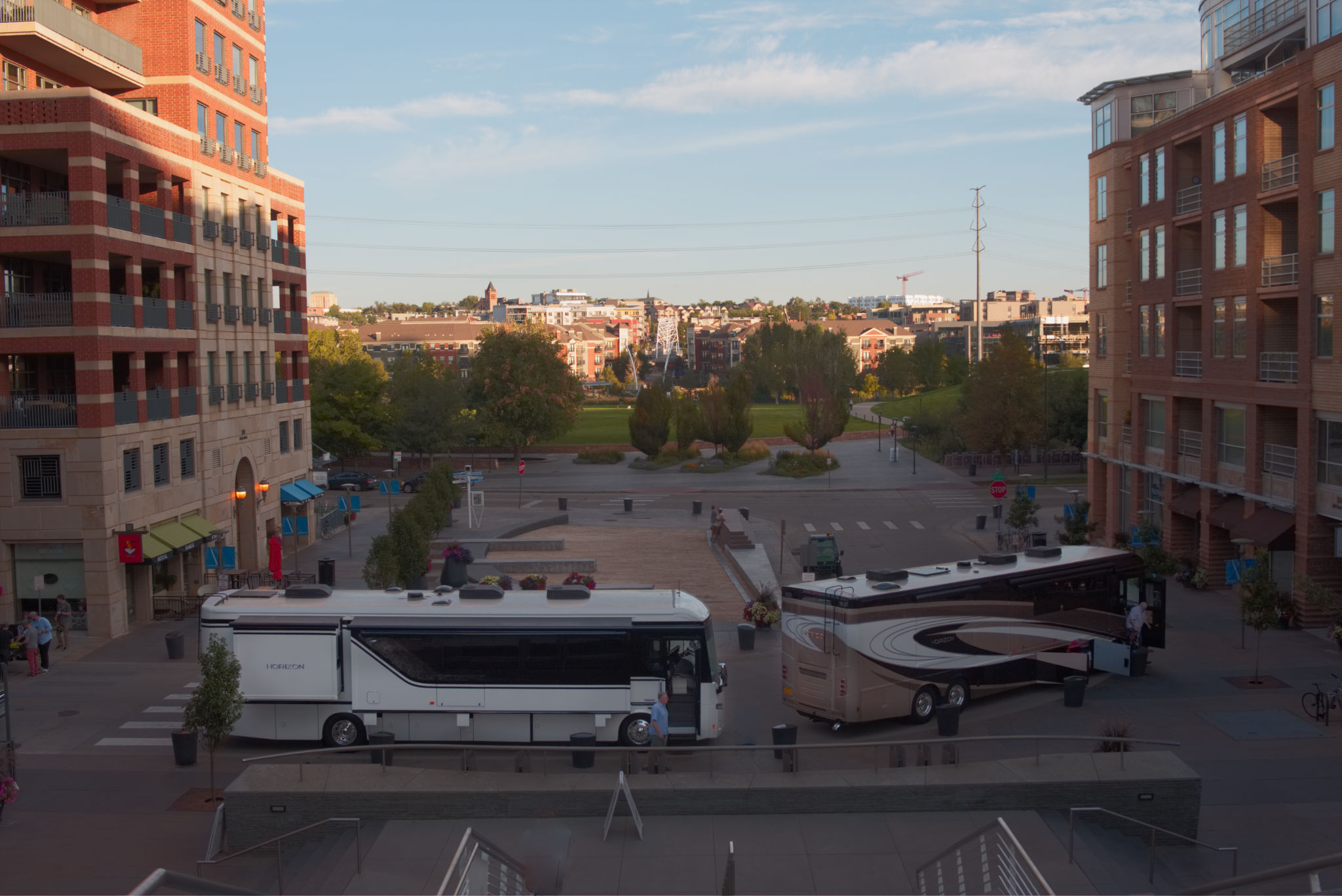 Prepositioned in lower downtown Denver early in the morning, two Horizons are made ready for a private preview showing.
Prepositioned in lower downtown Denver early in the morning, two Horizons are made ready for a private preview showing.
Ahead of time, the marketing team had determined a stopping point at the top of the bridge that offered a panoramic view, yet held the Horizons below out of sight. On a well-rehearsed schedule, Roske addressed the group and, with a few steps forward the Horizons were now revealed. For the next hour, the coaches were carefully studied from the inside out.
Million-Dollar Motorhome?
For Roske, the harbinger of things to come was both with the positive reactions of the group and then a small procession of neighborhood locals who were keen to poke their heads in. This was the first time anyone from the public had gotten to see these motorhomes. They were drawn in by the clean exterior design and bowled over by the quiet sophistication of the interiors. The comments were telling, "Is this a million dollar motorhome? I have never thought of having an RV, but this would change my mind. I'm calling my husband, he needs to see this."
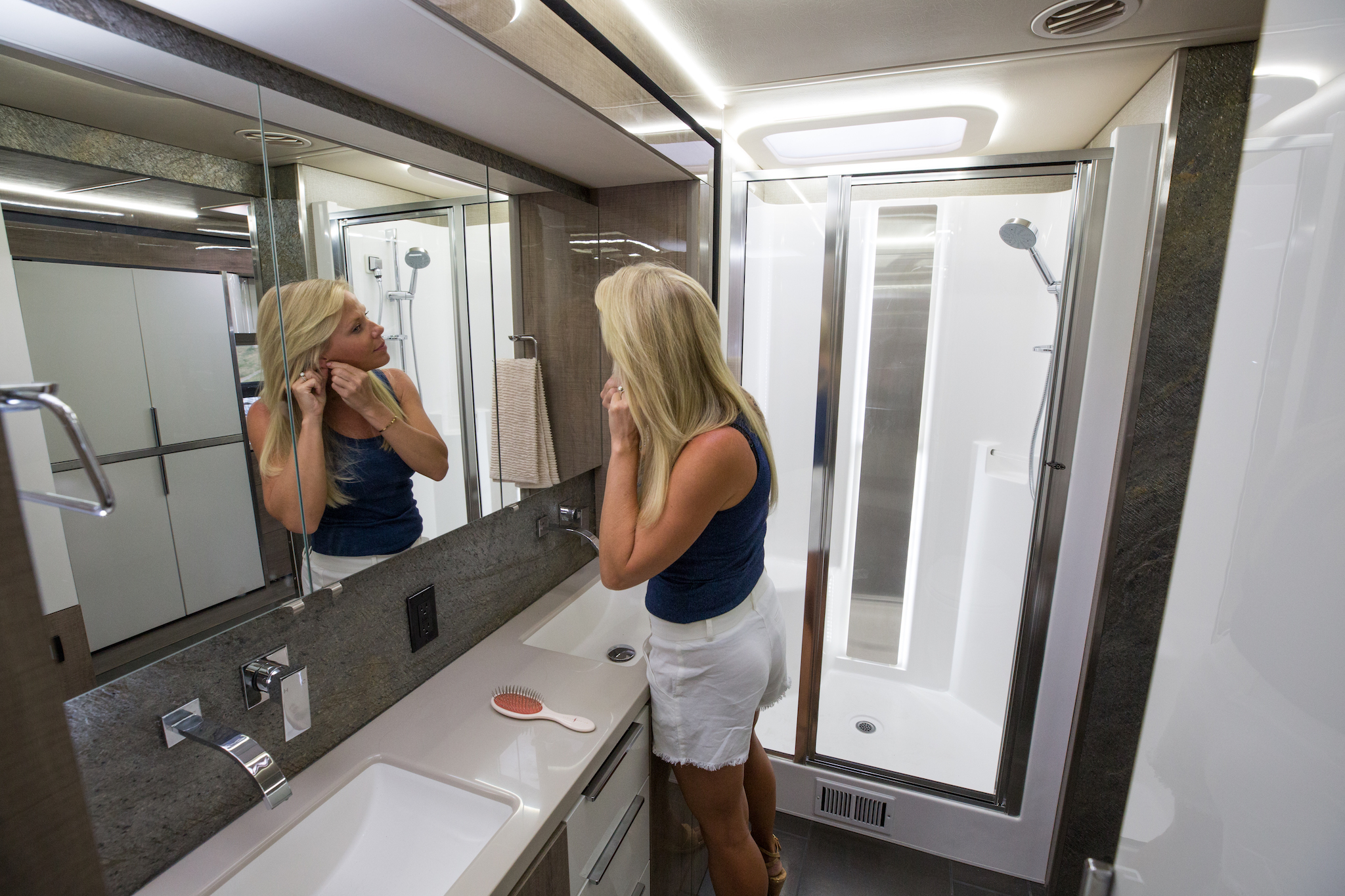 The Horizon's spacious bathroom suggests a modern luxury hotel suite.
The Horizon's spacious bathroom suggests a modern luxury hotel suite.
Over the next several months at industry-only events, the word of the Horizon spread quickly. Skeptical dealers realized that Winnebago was quite prescient in understanding the strong consumer appeal of the first truly modern Class A motor coach of the twenty-first century. Winnebago had unlocked new interest in a static segment by elevating design. And within two months of its announcement, the order backlog for the Horizon assured the manufacturing team at the Junction City plant that they would be very busy for months to come.
At the Recreational Vehicle Industry Association's annual industry trade show in Louisville, Kentucky, in early December 2017, the stream of dealers, press, and competitors walking through the Horizons on display was continual. And at an industry social event in downtown Louisville the publisher of RV Business magazine, Sherman Goldenberger, shook Roske's hand as the Horizon was named "RV of the Year." The doubts, second-guessing, and uncertainty of three years vanished in that moment.
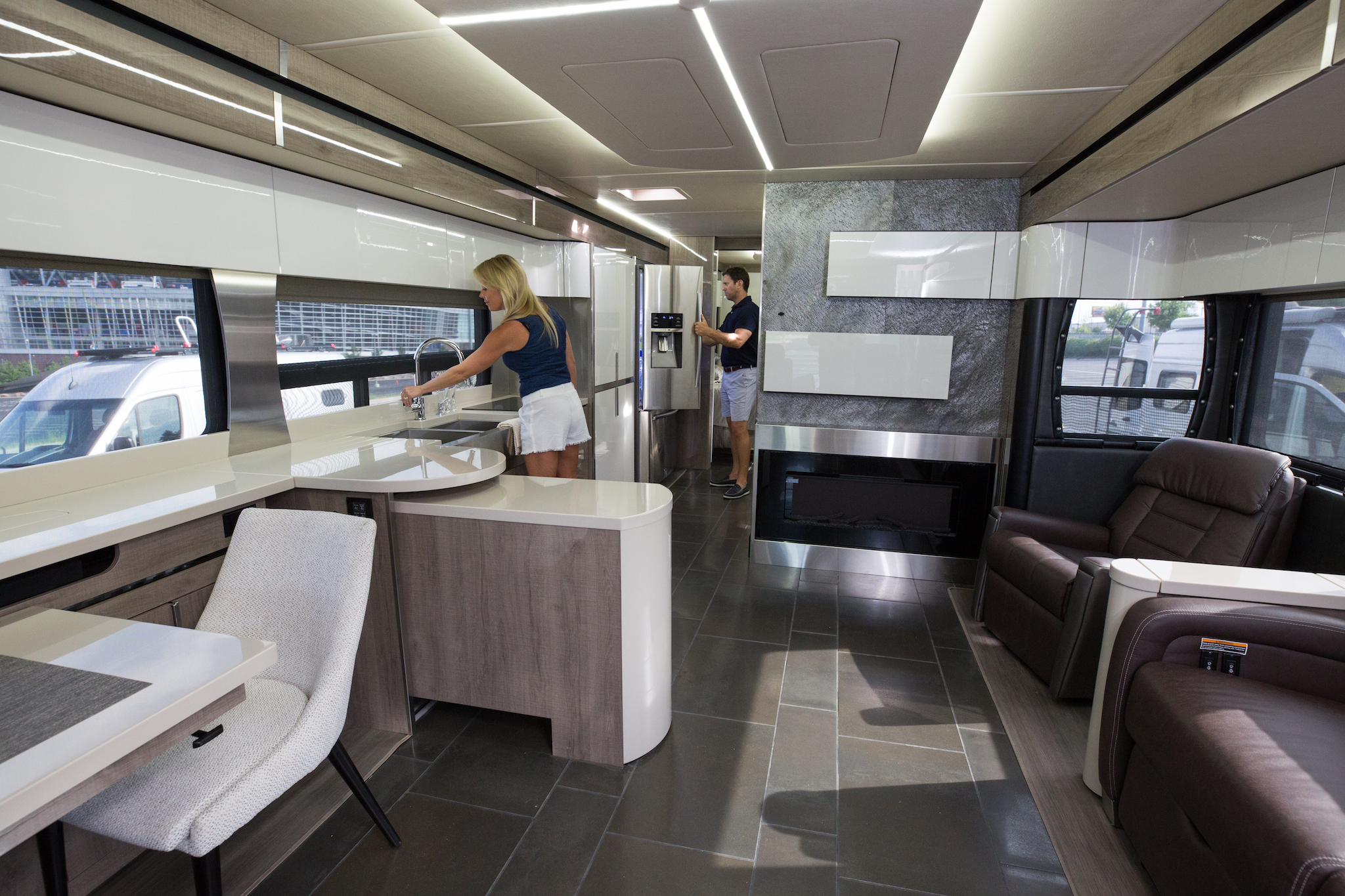 With the clean lines of a luxury yacht, the Horizon redefines modern motiorhcoach interiors.
With the clean lines of a luxury yacht, the Horizon redefines modern motiorhcoach interiors.
The introduction of the Winnebago Horizon had earned a mark on the historical timeline of RV history. It was one of those inflection points where a singular product changes perceptions and competitors change plans.
It was now late fall and the precise GPS guided planting of green rows of Iowan corn and soy beans had long been tilled under to wait for spring renewal. A northern wind pushed the idea of winter coming closer as Roske walked out to his car. Behind him, most of the buildings sprawled across more than a square mile of campus, had grown quiet following the final afternoon shift. Just another day at the office. But, like Roske's sleek new Horizon, the company behind him was changing too and showing that talent, innovation, vision, risk and hard work were alive and well and doing just fine growing in the American heartland.
************************
About the Horizon The new Winnebago Horizon comes in two floor plans starting at an MSRP of $385,214. In addition to its first-in-the-market contemporary design, Winnebago also offers an industry-leading three-year coach warranty on the Horizon and all their diesel pusher products. You can see specs, photos, virtual tours, and videos by visiting the Horizon web site.
Comments
Comments on this post are moderated, so they will not appear instantly. All relevant questions and helpful notes are welcome! If you have a service inquiry or question related to your RV, please reach out to the customer care team directly using the phone numbers or contact form on this page .